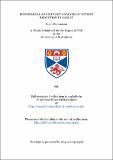Files in this item
Biochemical and mutant analysis of nitrite reduction in barley
Item metadata
| dc.contributor.advisor | Wray, John L. | |
| dc.contributor.author | Duncanson, Euan | |
| dc.coverage.spatial | 180 p. | en_US |
| dc.date.accessioned | 2018-06-22T13:31:23Z | |
| dc.date.available | 2018-06-22T13:31:23Z | |
| dc.date.issued | 1991 | |
| dc.identifier.uri | https://hdl.handle.net/10023/14465 | |
| dc.description.abstract | The object of this study was to isolate and characterise barley mutants that lacked a functional nitrite reductase activity. This work should complement previous studies on nitrate reductase to develop a fuller understanding of nitrate assimilation in barley. 30 nitrite reduction-deficient M2 barley plants (azide-treated in the M1) were identified as nitrite accumulators after treatment with nitrate. Biochemical analysis M2 selections revealed that leaf tissue from 9 selected plants lacked detectable nitrite reductase protein. Progeny from 4 of the selected plants (Golden Promise 2406, Tweed 3999, Klaxon 1010 and Klaxon 2760) inherited the phenotype of a lack of leaf nitrite reductase protein. These plants also lacked significant in vitro nitrite reductase activity. However, in vitro nitrate reductase and nitrate accumulation were comparable with wild type controls. Root tissue from nitrate-treated progeny of Golden Promise 2406, Tweed 3999, Klaxon 1010 and Klaxon 2760 also lacked nitrite reductase protein. Loss of nitrite reductase protein in selection Tweed 3999 was caused by a single recessive nuclear gene mutation. Thus, these plants are defective in nitrite reduction due to the inherited loss of nitrite reductase protein molecules in both leaf and root after treatment with nitrate in the light. This defect is caused by a mutation within a single nuclear gene in selection Tweed 3999. Analysis of wild type barley cv. Golden Promise revealed that increases in nitrite reductase activity in response to treatment with nitrate and light in leaf tissue and with nitrate in root tissue are due to de novo synthesis of enzyme molecules. In situ immunogold labelling of barley leaf sections with nitrite reductase antiserum demonstrates that the majority of labelling occurs within the chloroplasts. | en_US |
| dc.language.iso | en | en_US |
| dc.publisher | University of St Andrews | |
| dc.subject.lcc | QK898.E58D7 | en |
| dc.subject.lcsh | Plant enzymes | en |
| dc.title | Biochemical and mutant analysis of nitrite reduction in barley | en_US |
| dc.type | Thesis | en_US |
| dc.type.qualificationlevel | Doctoral | en_US |
| dc.type.qualificationname | PhD Doctor of Philosophy | en_US |
| dc.publisher.institution | The University of St Andrews | en_US |
This item appears in the following Collection(s)
Items in the St Andrews Research Repository are protected by copyright, with all rights reserved, unless otherwise indicated.

